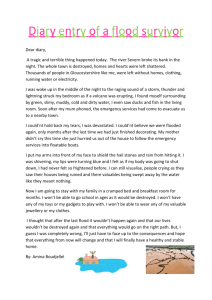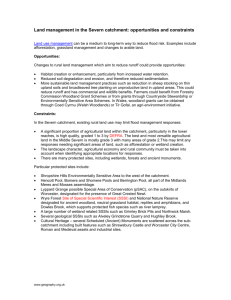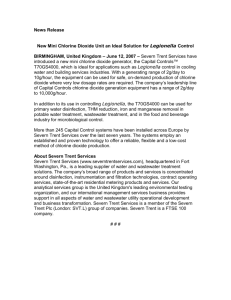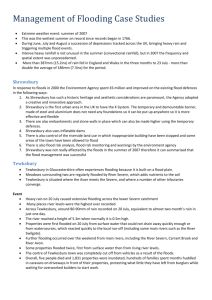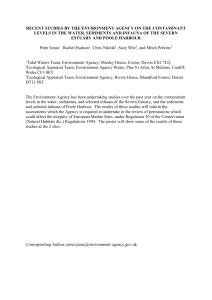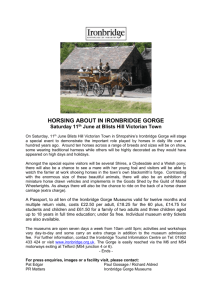RIVERS
advertisement
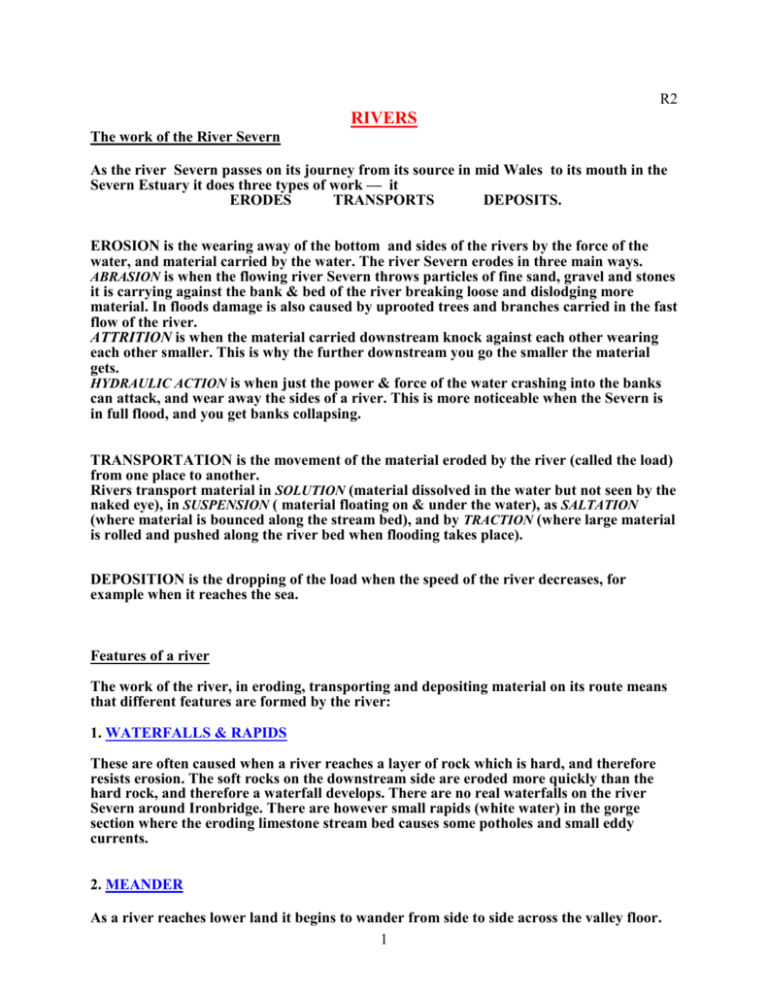
R2 RIVERS The work of the River Severn As the river Severn passes on its journey from its source in mid Wales to its mouth in the Severn Estuary it does three types of work — it ERODES TRANSPORTS DEPOSITS. EROSION is the wearing away of the bottom and sides of the rivers by the force of the water, and material carried by the water. The river Severn erodes in three main ways. ABRASION is when the flowing river Severn throws particles of fine sand, gravel and stones it is carrying against the bank & bed of the river breaking loose and dislodging more material. In floods damage is also caused by uprooted trees and branches carried in the fast flow of the river. ATTRITION is when the material carried downstream knock against each other wearing each other smaller. This is why the further downstream you go the smaller the material gets. HYDRAULIC ACTION is when just the power & force of the water crashing into the banks can attack, and wear away the sides of a river. This is more noticeable when the Severn is in full flood, and you get banks collapsing. TRANSPORTATION is the movement of the material eroded by the river (called the load) from one place to another. Rivers transport material in SOLUTION (material dissolved in the water but not seen by the naked eye), in SUSPENSION ( material floating on & under the water), as SALTATION (where material is bounced along the stream bed), and by TRACTION (where large material is rolled and pushed along the river bed when flooding takes place). DEPOSITION is the dropping of the load when the speed of the river decreases, for example when it reaches the sea. Features of a river The work of the river, in eroding, transporting and depositing material on its route means that different features are formed by the river: 1. WATERFALLS & RAPIDS These are often caused when a river reaches a layer of rock which is hard, and therefore resists erosion. The soft rocks on the downstream side are eroded more quickly than the hard rock, and therefore a waterfall develops. There are no real waterfalls on the river Severn around Ironbridge. There are however small rapids (white water) in the gorge section where the eroding limestone stream bed causes some potholes and small eddy currents. 2. MEANDER As a river reaches lower land it begins to wander from side to side across the valley floor. 1 R2 Erosion, particularly in flood conditions tends to be horizontal (sideways). The bend in the river caused by this wandering is called a meander. There are some excellent meanders west of Ironbridge towards the village of Cressage. 3. OX-BOW LAKE When the river water turns around the bend of a meander the water on the outside of the bend moves faster than the water on the inside. Faster moving water erodes more quickly and therefore gradually the outside bend the river is eroded back. Eventually 2 bends in the river may meet each other and the river breaks through taking the most direct route. The old bend in the river is then left as a lake, which is called an ox-bow lake. In time old oxbows silt up and only traces of them can be seen in the landscape. FORMATION OF OX-BOW LAKE 4. RIVER CLIFF & SLIP OFF SLOPE The water flowing around the bends of the River Severn move in a corkscrew movement. This means that erosion takes place on the outside of the bend and deposition takes place on the inside. Where the river is eroding most quickly on the outside of the bend a steep side is cut into the land, and this is called a river-cliff 2 R2 A PLAN & SECTION OF A RIVER BEND water direction deposition F= fast water flow D= deepest water S =slower water flow Sh=shallowest water 5. FLOOD PLAIN As the River Severn flows along the valley floor between Shrewsbury & Ironbridge it can overflow and flood after a period of heavy rainfall further upstream. With the flooding a deposit of fine silt and mud spreads onto the valley floor. The part of the valley floor that is sometimes covered by the river when it floods is called the flood plain . Ox-bow lakes are often found in a flood plain. 3 R2 6. SEDIMENT The material that is carried by the Severn and then deposited is called sediment. This may be the remains of rocks that were eroded by the river in Wales and have then been broken down by rubbing against each other and the sides and bottom of the river valley to become almost like sand. The sediment is deposited in layers on the valley floor, on the bends in the river and at the mouth of the river as it enter the sea. To make it confusing sediment is also called silt, alluvium sand & gravel depending on the size & type of material deposited. 7. LEVEES & FLOOD BANKS As the river deposits material on its bed and banks, this material builds up, and sometimes the level of the river may be above that of the flood plain. The banks of the river are called levees (from the French verb lever meaning to rise or get up). Artificial banks may be made out of steel mesh cages full of stones, concrete, steel plates and earth to stop a river flooding onto farm land, roads, railtracks and housing. 8. VALLEY & RIVER SHAPES If you followed the course of the River Severn from it’s source in Mid Wales at Plynlimmon, the altitude at the start would be 752 meters in height. As the river flows east and then southwards the river drops in height until it reaches the sea at 0 meters. A graph drawn of this drop in altitude is called a River Profile. The Severn is different from most UK rivers in that halfway along its course the river is forced to flow through the Ironbridge Gorge and this is like a bottle neck forcing the river to flood over the flood plain west of Ironbridge. It also makes the water in the gorge fast & dangerous at times. After the straight section of the gorge bottle neck the Severn starts to meander again on it’s way to the sea. Severn source in Wales 4 ! ! steep early section Ironbridge Gorge almost flat lower section R2 Severn Estuary stes RIVER SEVERN PROFILE If a cross - section slice is drawn across the Severn valley at different points on its profile, the valley forms different shapes depending if the river is in the hills & mountains of Wales, in the Ironbridge Gorge or in the flood plain sections north or south of the gorge.. 9. RIVER TERRACES There are some clear sets of river terraces on the Severn near Ironbridge. A river terrace shows the width & height of the river many years ago. In some cases 17000 years ago when there was a lot more water in the Severn with the melting snow fields in Wales. Even 10000 years ago the Severn was much wider than it is today. It is hard to imagine that the roadside lay by and viewpoint at Leighton (619049) west of Ironbridge was once the north 5 R2 bank of the Severn. T = terrace C = confluence where two streams /rivers meet PHOTOGRAPHS Look at the photographs to see some of the river features mentioned above. 6
